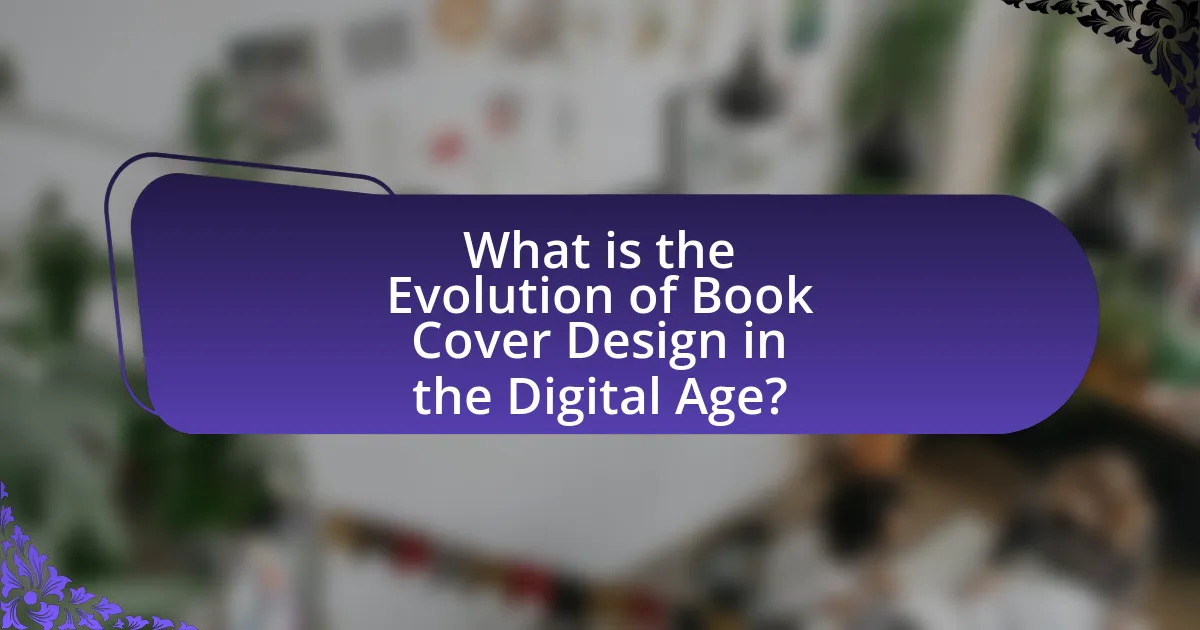The article examines the evolution of book cover design in the digital age, highlighting how technological advancements and changing consumer behaviors have transformed the field. It discusses the impact of digital tools, such as Adobe Creative Suite and Canva, on the design process, as well as the significance of visual aesthetics in online marketplaces where 75% of consumers make purchasing decisions based on cover design. Key trends, including minimalism and bold typography, are explored alongside historical milestones that have shaped book cover design. The article also addresses challenges designers face, such as copyright issues and the need for cross-platform compatibility, while emphasizing best practices for creating effective and compelling book covers in a competitive digital landscape.

What is the Evolution of Book Cover Design in the Digital Age?
The evolution of book cover design in the digital age has transformed significantly due to advancements in technology and changes in consumer behavior. Digital platforms have enabled designers to create more visually engaging and diverse cover art, utilizing tools like Adobe Creative Suite and 3D modeling software, which were not as accessible in the print-dominated era. Additionally, the rise of e-books has shifted the focus from physical aesthetics to digital visibility, leading to the importance of thumbnail images that capture attention in online marketplaces. Research indicates that 75% of consumers make purchasing decisions based on cover design, underscoring the critical role of effective visual branding in a digital context. This evolution reflects a blend of traditional design principles with modern digital strategies, adapting to the needs of a rapidly changing market.
How has technology influenced book cover design?
Technology has significantly influenced book cover design by enabling advanced graphic design tools and digital printing techniques. These innovations allow designers to create intricate and visually appealing covers that were previously difficult or impossible to achieve. For instance, software like Adobe Photoshop and Illustrator provides extensive capabilities for image manipulation and typography, leading to more creative and diverse designs. Additionally, digital printing technology has reduced costs and increased the speed of production, allowing for more experimentation with materials and finishes, such as matte or glossy coatings. This evolution has resulted in a wider variety of cover styles and formats, catering to different genres and reader preferences, ultimately enhancing the visual appeal and marketability of books.
What digital tools are commonly used in modern book cover design?
Commonly used digital tools in modern book cover design include Adobe Photoshop, Adobe InDesign, and Canva. Adobe Photoshop is widely utilized for image editing and manipulation, allowing designers to create visually striking graphics. Adobe InDesign is favored for layout design, enabling the arrangement of text and images in a cohesive manner. Canva offers an accessible platform for both professional and amateur designers, providing templates and design elements that simplify the cover creation process. These tools are integral to the design workflow, enhancing creativity and efficiency in producing compelling book covers.
How do digital platforms affect the aesthetics of book covers?
Digital platforms significantly influence the aesthetics of book covers by prioritizing visual elements that attract online consumers. The rise of e-commerce and social media has led to a trend where book covers must be visually striking and easily recognizable in small digital formats, such as thumbnails. Research indicates that 70% of consumers make purchasing decisions based on cover design when browsing online, highlighting the importance of aesthetic appeal in digital environments. Additionally, digital platforms encourage the use of bold colors, minimalist designs, and typography that stands out, as these elements are more likely to capture attention in a crowded marketplace.
What are the historical milestones in book cover design?
The historical milestones in book cover design include the introduction of the first printed book, the Gutenberg Bible in 1455, which featured a simple cover design. In the 19th century, the rise of mass production led to the use of illustrated covers, with notable examples like the 1830s publication of “The Pickwick Papers” by Charles Dickens, which showcased colorful and artistic designs. The early 20th century saw the emergence of modernist design principles, exemplified by the 1920s covers of Penguin Books, which standardized cover formats and emphasized typography. The digital age has further transformed book cover design, with the advent of e-books and online publishing, leading to innovative designs that cater to digital platforms. These milestones reflect the evolution of aesthetics and technology in book cover design throughout history.
How did the advent of printing press change book cover design?
The advent of the printing press revolutionized book cover design by enabling mass production and standardization of books, which led to the introduction of more elaborate and artistic cover designs. Prior to the printing press, books were hand-copied and often lacked covers or had simple, utilitarian designs. With the ability to print multiple copies efficiently, publishers began to invest in visually appealing covers to attract readers, incorporating illustrations, typography, and decorative elements. This shift is evidenced by the emergence of printed covers in the 15th century, such as those produced by Aldus Manutius, who popularized the use of title pages and ornamental designs, setting a precedent for future book cover aesthetics.
What role did graphic design movements play in shaping book covers?
Graphic design movements significantly influenced the aesthetics and functionality of book covers by introducing innovative styles and concepts. For instance, the Bauhaus movement emphasized simplicity and geometric forms, which led to minimalist book cover designs that prioritize clarity and visual impact. Similarly, the Art Deco movement brought in bold colors and intricate patterns, enhancing the visual appeal of book covers during the early 20th century. These movements not only shaped the visual language of book covers but also reflected cultural and societal changes, making them more than just protective layers; they became integral to the marketing and identity of the books themselves. The impact of these movements is evident in the evolution of design trends, where modern covers often draw inspiration from historical styles, demonstrating the lasting legacy of graphic design movements in the publishing industry.
Why is book cover design important in the digital age?
Book cover design is crucial in the digital age because it serves as the first point of visual engagement for potential readers. In an environment saturated with digital content, an eye-catching cover can significantly influence a reader’s decision to click on or purchase a book. Research indicates that 75% of consumers judge a book by its cover, highlighting the importance of effective design in attracting attention and conveying the book’s genre and tone. Additionally, with the rise of e-books and online marketplaces, a compelling cover can differentiate a title in a crowded digital space, ultimately impacting sales and visibility.
How does a book cover impact consumer purchasing decisions?
A book cover significantly impacts consumer purchasing decisions by serving as the first visual interaction a potential reader has with the book. Research indicates that 75% of consumers make purchasing decisions based on a book’s cover design, highlighting its critical role in attracting attention and conveying genre and tone. Effective cover designs utilize color, typography, and imagery to evoke emotions and create a connection with the target audience, ultimately influencing their choice to buy. For instance, a study published in the Journal of Consumer Research found that covers that align with consumer expectations of a genre lead to higher purchase intentions.
What psychological factors influence the effectiveness of book covers?
The psychological factors that influence the effectiveness of book covers include color psychology, visual aesthetics, and cognitive fluency. Color psychology affects emotions and perceptions; for instance, blue often conveys trust, while red can evoke excitement. Visual aesthetics, such as imagery and typography, play a crucial role in attracting attention and conveying genre, which helps readers quickly identify their interests. Cognitive fluency refers to how easily information is processed; simpler designs tend to be more appealing and memorable. Research indicates that covers that align with genre expectations and evoke positive emotional responses significantly increase purchase likelihood, as demonstrated in studies by Hagtvedt and Brasel (2017) in the Journal of Consumer Research.

What are the current trends in book cover design?
Current trends in book cover design include minimalism, bold typography, and the use of vibrant colors. Minimalism emphasizes simplicity, often featuring clean lines and limited imagery, which caters to the digital audience’s preference for clarity. Bold typography is increasingly popular, as it captures attention and conveys the book’s theme effectively. Additionally, vibrant colors are being utilized to create eye-catching designs that stand out in online marketplaces. These trends reflect the need for covers to be visually appealing in both physical and digital formats, aligning with consumer behavior that favors striking visuals in a crowded market.
How are minimalist designs shaping modern book covers?
Minimalist designs are significantly shaping modern book covers by emphasizing simplicity and clarity, which enhances visual appeal and marketability. This design approach often utilizes limited color palettes, clean typography, and ample white space, allowing key elements to stand out and communicate the book’s essence effectively. For instance, the rise of e-commerce and digital platforms has led publishers to adopt minimalist aesthetics to ensure that book covers are eye-catching in thumbnail formats, which is crucial for online sales. Research indicates that minimalist designs can improve consumer recognition and recall, making them a strategic choice in a crowded marketplace.
What are the characteristics of successful minimalist book covers?
Successful minimalist book covers are characterized by simplicity, strong typography, and effective use of negative space. Simplicity allows the design to convey the essence of the book without unnecessary elements, making it visually appealing and easy to understand at a glance. Strong typography ensures that the title and author’s name are prominent and legible, often using a limited color palette to enhance readability. Effective use of negative space creates a balanced composition, drawing attention to key elements and allowing the cover to breathe. These characteristics are supported by design principles that emphasize clarity and focus, which are essential in a digital marketplace where first impressions are critical.
How do color schemes play a role in minimalist designs?
Color schemes are fundamental in minimalist designs as they enhance visual clarity and focus. In minimalist design, a limited color palette reduces distractions, allowing the essential elements to stand out. For instance, the use of monochromatic or analogous color schemes can create a sense of harmony and balance, which is crucial in conveying a clear message. Research indicates that effective color choices can influence user perception and emotional response, making them vital in design contexts, including book covers. A study by the University of California found that color can increase brand recognition by up to 80%, underscoring its importance in minimalist aesthetics where simplicity and impact are key.
What role does typography play in contemporary book cover design?
Typography plays a crucial role in contemporary book cover design by influencing visual appeal and conveying the book’s genre and tone. Effective typography enhances readability and establishes a connection with the target audience, making it a key element in attracting potential readers. For instance, the choice of font style, size, and color can evoke specific emotions or associations, such as using bold sans-serif fonts for thrillers to suggest urgency or elegant serif fonts for literary fiction to imply sophistication. Research indicates that 95% of first impressions are based on visual appearance, underscoring the importance of typography in creating an impactful cover that resonates with consumers.
How do font choices affect the perception of a book’s genre?
Font choices significantly influence the perception of a book’s genre by conveying specific emotional and thematic cues associated with different styles. For instance, serif fonts often evoke a sense of tradition and seriousness, making them suitable for genres like historical fiction or literary works, while sans-serif fonts tend to appear modern and clean, aligning well with genres such as contemporary fiction or non-fiction. Research indicates that readers make genre assumptions based on visual elements, including typography; a study published in the journal “Psychology of Aesthetics, Creativity, and the Arts” found that font style can alter readers’ expectations about a book’s content and tone. Thus, the selection of font not only enhances aesthetic appeal but also plays a crucial role in genre identification and reader engagement.
What are the emerging typography trends in book covers?
Emerging typography trends in book covers include the use of bold, oversized fonts, minimalistic designs, and a focus on custom typography. Bold, oversized fonts create visual impact and attract attention, making them popular in contemporary design. Minimalistic designs often feature clean lines and ample white space, allowing the typography to stand out without distraction. Custom typography is increasingly utilized to convey the unique voice of the book, enhancing brand identity and reader engagement. These trends reflect a shift towards more expressive and personalized design approaches in the digital age, where visual appeal is crucial for capturing audience interest.
How do social media and online marketing influence book cover design?
Social media and online marketing significantly influence book cover design by prioritizing visual appeal and marketability to capture audience attention. The prevalence of platforms like Instagram and Pinterest, where visual content thrives, drives designers to create covers that are not only aesthetically pleasing but also shareable and engaging. Research indicates that books with striking covers are more likely to be shared online, leading to increased visibility and sales. For instance, a study by the Book Industry Study Group found that 75% of consumers make purchasing decisions based on cover design, underscoring the importance of aligning cover aesthetics with online marketing strategies.
What strategies are authors using to promote their book covers online?
Authors are using social media marketing, influencer partnerships, and targeted advertising to promote their book covers online. Social media platforms like Instagram and Facebook allow authors to showcase visually appealing book covers, engage with readers, and build a following. Influencer partnerships enable authors to leverage established audiences, increasing visibility and credibility. Additionally, targeted advertising on platforms such as Amazon and Google allows authors to reach specific demographics, enhancing the effectiveness of their promotional efforts. These strategies collectively contribute to increased awareness and sales of books in the digital marketplace.
How does audience feedback shape book cover design choices?
Audience feedback significantly influences book cover design choices by providing insights into reader preferences and market trends. Designers often analyze feedback from focus groups, surveys, and social media to understand what visual elements resonate with potential readers. For instance, a study by the Book Industry Study Group found that 75% of readers consider cover design a crucial factor in their purchasing decisions. This data drives designers to create covers that align with audience expectations, ensuring that elements like color, typography, and imagery appeal to the target demographic. Consequently, audience feedback acts as a vital tool for publishers and designers to enhance marketability and connect with readers effectively.

What challenges do designers face in the digital age?
Designers face several challenges in the digital age, including the rapid pace of technological change, the need for cross-platform compatibility, and the saturation of digital content. The rapid evolution of design tools and software requires designers to continuously update their skills to remain relevant. Additionally, ensuring that designs function seamlessly across various devices and screen sizes adds complexity to the design process. The overwhelming amount of digital content makes it difficult for designers to create standout visuals that capture attention, as studies indicate that consumers are exposed to thousands of advertisements daily, leading to increased competition for visibility.
How do copyright issues affect book cover design?
Copyright issues significantly impact book cover design by restricting the use of images, fonts, and other design elements that may be protected under copyright law. Designers must ensure that any artwork or typography used is either original, licensed, or falls under fair use to avoid legal repercussions. For instance, using a famous painting or a well-known photograph without permission can lead to copyright infringement claims, which can result in costly lawsuits or the need to redesign the cover entirely. Additionally, copyright laws vary by country, adding complexity for designers working in international markets. Therefore, understanding and navigating copyright issues is essential for creating compliant and effective book cover designs.
What are the common legal pitfalls in using images and fonts?
Common legal pitfalls in using images and fonts include copyright infringement, trademark violations, and licensing issues. Copyright infringement occurs when images or fonts are used without permission from the copyright holder, which can lead to legal action and financial penalties. Trademark violations arise when a font or image is associated with a brand without authorization, potentially causing confusion among consumers. Licensing issues often involve using images or fonts beyond the scope of their licenses, which can result in legal disputes. According to the U.S. Copyright Office, unauthorized use of copyrighted materials can lead to statutory damages ranging from $750 to $30,000 per work, reinforcing the importance of adhering to copyright laws.
How can designers navigate copyright laws effectively?
Designers can navigate copyright laws effectively by understanding the principles of copyright, utilizing original designs, and seeking permission for any copyrighted materials. Knowledge of copyright law, including the duration of protection and fair use provisions, allows designers to create works that respect existing intellectual property. For instance, the U.S. Copyright Office states that original works of authorship are automatically protected upon creation, emphasizing the importance of originality in design. Additionally, designers should consider licensing agreements when using third-party content, ensuring they have the right to use such materials legally. This approach minimizes the risk of infringement and fosters a respectful creative environment.
What are the limitations of digital book cover design?
Digital book cover design has several limitations, primarily related to the constraints of digital formats and the challenges of visual impact in a crowded marketplace. One significant limitation is the reduced ability to convey intricate details and textures that physical covers can showcase, which can affect the overall aesthetic appeal. Additionally, digital covers must compete for attention in online platforms where numerous titles are displayed simultaneously, making it difficult for individual designs to stand out. Research indicates that 75% of consumers make purchasing decisions based on visual appeal, highlighting the importance of effective design in a saturated digital environment. Furthermore, the reliance on screen resolution can lead to discrepancies in how covers appear across different devices, potentially diminishing the intended visual impact.
How does screen resolution impact design choices?
Screen resolution significantly impacts design choices by determining how visual elements are rendered and perceived on various devices. Higher screen resolutions allow for more detailed graphics, enabling designers to incorporate intricate designs, sharper text, and vibrant colors, which enhance the overall aesthetic appeal of book covers. For instance, a cover designed for a high-resolution display (like 4K) can utilize finer details that may not be visible on lower-resolution screens, such as standard HD displays. This difference necessitates that designers consider the target device’s resolution when creating covers to ensure optimal visual impact and readability, as studies show that images with higher clarity lead to better user engagement and retention.
What challenges arise from designing for both print and digital formats?
Designing for both print and digital formats presents challenges such as differing visual resolutions and user interactions. Print design requires high-resolution images and specific color profiles, while digital design must accommodate various screen sizes and resolutions, often leading to compromises in visual fidelity. Additionally, user engagement differs; print allows for tactile experiences, whereas digital formats require intuitive navigation and interactivity. These differences necessitate a flexible design approach that can adapt to the strengths and limitations of each medium, ensuring that the final product remains effective and appealing across both platforms.
What best practices should designers follow for effective book cover design?
Designers should prioritize clarity, visual hierarchy, and genre alignment for effective book cover design. Clarity ensures that the title and author’s name are easily readable, which is crucial for attracting potential readers. Visual hierarchy guides the viewer’s eye to the most important elements first, typically the title, followed by the author’s name and imagery. Aligning the design with the genre helps set reader expectations; for example, a thriller cover often uses darker colors and bold fonts, while a romance novel may feature softer colors and elegant typography. Research indicates that covers that adhere to these principles tend to perform better in sales and reader engagement, as they effectively communicate the book’s content and appeal to the target audience.
How can designers ensure their covers stand out in a crowded market?
Designers can ensure their covers stand out in a crowded market by employing unique visual elements, bold typography, and innovative layouts that capture attention. Research indicates that covers with distinctive imagery and color schemes can increase visibility; for instance, a study by the Book Industry Study Group found that 70% of readers are influenced by cover design when selecting a book. Additionally, incorporating trends such as minimalism or retro aesthetics can differentiate a cover from competitors, as seen in successful titles that leverage these styles. By understanding target audience preferences and utilizing market analysis, designers can create covers that not only attract attention but also resonate with potential readers.
What are the key elements of a compelling book cover in the digital age?
A compelling book cover in the digital age includes striking visuals, clear typography, and effective branding. Striking visuals capture attention quickly, as studies show that images can increase engagement by up to 94%. Clear typography ensures readability across various devices, with sans-serif fonts often preferred for digital formats due to their clarity. Effective branding aligns the cover design with the author’s established style or genre conventions, enhancing recognition and appeal. These elements collectively contribute to a book cover’s ability to attract potential readers in a crowded digital marketplace.



